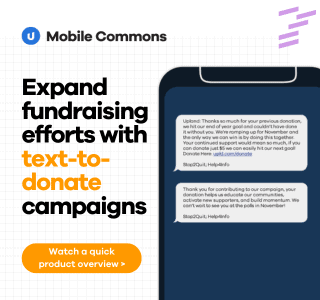 The mobile market is changing and that means healthcare marketing has to change with it. As mobile phones become ubiquitous, there’s a huge opportunity for healthcare marketers to capitalize on this shift, especially with today’s smartphone generation of millennials. They also can take their cues from other brands outside the industry, who have skillfully used an omni-channel approach and text message marketing to target consumers with relevant messaging at the right time and in the right context.
The mobile market is changing and that means healthcare marketing has to change with it. As mobile phones become ubiquitous, there’s a huge opportunity for healthcare marketers to capitalize on this shift, especially with today’s smartphone generation of millennials. They also can take their cues from other brands outside the industry, who have skillfully used an omni-channel approach and text message marketing to target consumers with relevant messaging at the right time and in the right context.
The Rise of the Smartphone-Only Generation
Data from the Pew Research Center indicates that going online is no longer about using a desktop or laptop. Around two-thirds of Americans own a smartphone and 19% of them rely on their phones to stay connected to the world. Pew’s research also shows that:
- Other than their phones, 15% of Americans have limited options for accessing online services.
- 10% of Americans only have a smartphone data plan for high speed Internet access at home.
- 7% of Americans are “smartphone-dependent,” with limited other options for online access and no home broadband service.
- 15% of people age 18 to 29 depend heavily on smartphones for online access.
The bottom line is that the number of smartphone-only users is on the rise and organizations need to think of new ways to reach this group. In particular, healthcare providers who have relied on traditional forms of marketing to reach patients may need to rethink their strategy and incorporate mobile.
Why Healthcare Institutions Must Engage with Mobile Marketing
 Erin Byrne, managing partner of Grey Marketing Group, believes that mobile is crucial for healthcare institutions. In an article on eMarketer, she says that mobile is a way to make institutions’ activities more relevant and to connect personally with patients. She describes mobile phones as “a remote control for your personal health,” adding that healthcare institutions can use mobile phones to help patients manage their health, allow patients to share information with their doctors and to send targeted, geo-specific reminders about buying relevant health-related products.
Erin Byrne, managing partner of Grey Marketing Group, believes that mobile is crucial for healthcare institutions. In an article on eMarketer, she says that mobile is a way to make institutions’ activities more relevant and to connect personally with patients. She describes mobile phones as “a remote control for your personal health,” adding that healthcare institutions can use mobile phones to help patients manage their health, allow patients to share information with their doctors and to send targeted, geo-specific reminders about buying relevant health-related products.
But should healthcare institutions only use mobile technologies like SMS to reach their customers? A recent study from Experian Marketing Services suggests that integrated campaigns work even better. In fact, one brand found that patients who received both SMS and email campaigns were 3.9 times more likely to take action than those who only received email.
The lesson here is that although healthcare marketers need to focus on connecting with mobile users, using multiple channels to reach them is more likely to drive success. Here are some examples from other industries to provide inspiration.
Multi-Channel Marketing: Case Studies
Seattle Sun Tan promoted its mobile marketing campaign on social media channels, on its website, and via email marketing, encouraging consumers to opt-in for a $20 off coupon. This omni-channel campaign generated $200,000 in sales for Seattle Sun Tan in its first four weeks.
Key Takeaway: Healthcare organizations can use social media, their website, and email lists to encourage mobile sign-ups, delivering a discount in exchange for data on potential customers. This helps to optimize future mobile-only and omni-channel campaigns, increasing the ROI of these efforts.
Build-a-Bear extended its customer relationships by linking an SMS campaign with a microsite. The aim was to replicate the in-store experience of choosing and dressing up a furry friend. When customers texted the keyword “DRESS” to the relevant number, they could access the microsite. Once they had dressed their furry friend, Build-a-Bear could bring it to life or let people share it on social media. Build-a-Bear says the campaign helped the company establish new customer relationships and transform mobile subscribers into social media brand advocates.
Key takeaway: Combining SMS with a microsite drives engagement and brand awareness. It also may create long-term brand advocates, generating organic, word-of-mouth marketing.
Another way CPG brands are using SMS to their advantage is how Pepsi is leveraging several channels as part of its partnership with the NFL. Customers could text several football-related keywords to enter a sweepstakes to win Pepsi gear. They also were taken to targeted microsites where they could earn rewards. Pepsi combined this effort with in-store promotions, leading to a text message campaign that the company described as “highly responsive.”
Key takeaway: Combining online with offline can boost responsiveness for mobile campaigns. By using SMS in partnership with other companies, healthcare organizations can incentivize patients to improve their health outcomes with rewards.
SMS Campaigns for Better Health
Retail and CPG brands aren’t the only ones capitalizing on SMS. Healthcare organizations have gained traction with SMS as part of either a multi-channel marketing campaign or a standalone one. Examples include:
- Sending text messages to a group of cardiovascular patients reminding them about managing their condition. The effort resulted in lower cholesterol, blood pressure and body mass index among those who received messages.
- Using personalized text messages in an anti-binge drinking campaign to help young adults make healthy decisions about drinking. Message recipients experienced a 12% drop in binge drinking as a result of receiving the communication.
- Encouraging patients with chronic pain through supportive text messages, which resulted in reduced pain reporting for recipients.
As a recent survey by Johns Hopkins found, mobile marketing offers great potential for patient connection and support. As these examples illustrate, it’s a tool all healthcare institutions should use to better serve patients and to expand their customer base.
To learn more about how Upland Mobile Messaging can be used to improve your omni-channel marketing efforts contact us.


